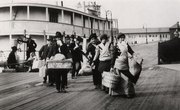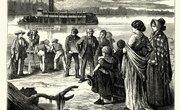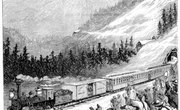In a journey chronicled in John Steinbeck’s novel “The Grapes of Wrath,” millions of migrant workers in the 1930s flocked to California in search of a better life. Fleeing the Midwest Dust Bowl, they hoped for a paradise where there was good weather and plentiful crops. What they found was back-breaking work, low pay and discrimination. The Mexican and Mexican-American migrant farm workers already in California faced displacement and harsh working conditions.
Why They Left Home
During the 1930s, more than 2.5 million people migrated to California. Most of those who migrated were from Great Plains states, including Oklahoma, Arkansas, Missouri and Texas. The migrants left their homes due to a mix of ecological and environmental issues.
Economically, many Great Plains farmers were impacted by the recession that followed World War I. They felt pressured to increase their farming productivity by using machines, which were expensive investments. Things got worse for farmers after the 1929 stock market crash, and many were unable to keep up the payments on their farms and equipment. Small farmers lost their farms, leading them to seek work elsewhere.
The overfarming of the Great Plains also led to the Dust Bowl. As fields were cultivated and farmed, the topsoil began to erode. A seven-year drought started in 1931 and intense dust storms started the following year. Farms literally blew away, creating the Dust Bowl and leading even more farmers to leave home for the promise of better opportunities.
What They Found
Popular music of the era painted California as a promised land of fertile fields and mild weather. Migrant families packed up and drove to California following Route 66. They did not receive a warm welcome as they crossed into the state, though. Some were met by state border patrols who told them there was no work available and urged them to turn back. Many still proceeded, though, settling in the Los Angeles area as well as California’s Central Valley. Locals felt the migrant workers were ignorant and backward, and referred to them derisively as “Okies.”
Daily Life
As migrants arrived in California, there were far more workers than available jobs. This overabundance of laborers drove down wages. Many migrants set up camp along the irrigation ditches of the farms they were working, which led to overcrowding and poor sanitary conditions. They lived in tents and out of the backs of cars and trucks. The working hours were long, and many children worked in the fields with their parents. Working conditions were often unsafe and unsanitary. Migrant workers had to follow the harvest of different crops, so they had to continue to pack up and move throughout California to find work.
When the migrant workers weren’t working, they enjoyed recreational and social activities. Many sang and played instruments. They also held dances and played games. Some larger camps had a newsletter that outlined the social activities available.
Mexican and Mexican-American Migrant Workers
Mexican and Mexican-American migrant workers had a different experience in the 1930s. Many had immigrated from Mexico in the early 1900s due to civil wars. As migrant workers flooded into California from the Midwest, many Mexican and Mexican-American workers were pushed out of their jobs. Those that were still able to find farm work saw their wages decrease. They began to band together to organize and protest with limited success until the farm labor movement of the 1960s.
Related Articles
References
Resources
Writer Bio
Melinda Hill Sineriz has been writing professionally for over 10 years. She worked as an editorial assistant for Forward Movement Publications in Cincinnati, Ohio. She wrote for several years for allmusic.com and edited and wrote a chapter for a book with Wooster Press. She graduated from Miami University in Ohio with a Bachelor of Arts in English. She has a master's degree in teaching.











